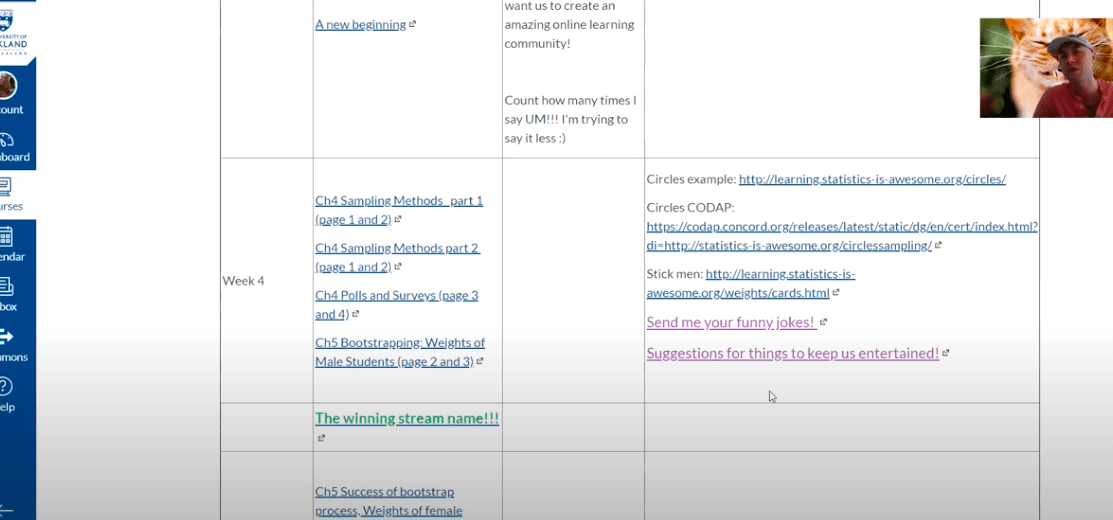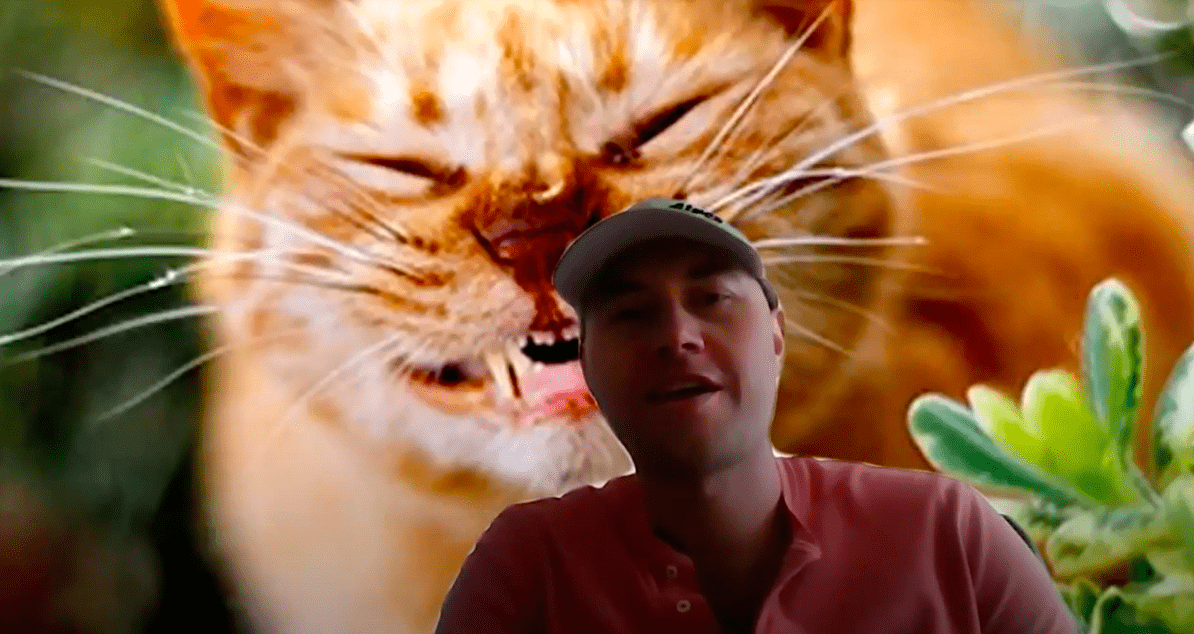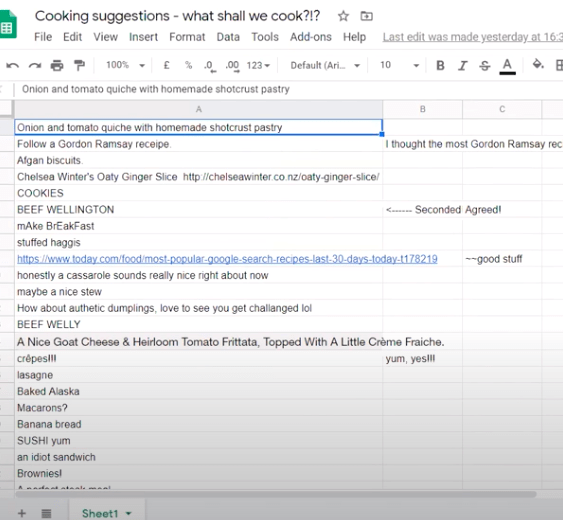Engaging Remote Learning (Science)
Dr Rhys Jones from Statistics in the Faculty of Science at the University of Auckland took Zooming to the next level, using creative strategies to engage and motivate students of STATS 101/101G/108: Introduction to Statistics in 2020. Ideas from this case study will be useful if faced with challenges of remote teaching to large cohorts, or if you are interested in creative strategies for motivating and engaging all students.
Background
In large courses like STATS 101/101G/108: Introduction to Statistics that can have over 5500 enrolled students a year, there can be problems keeping students engaged and motivated, particularly in large lecture halls. When face-to-face teaching ended during the semester due to the global pandemic, the need to motivate and engage students became even more important, which provided the impetus to create and implement the activities outlined in this case study. There were approximately 2400 in the entire cohort for STATS 101/101G/108: Introduction to Statistics in Semester One, 2020. This case study focuses on the use of Google Sheets with embedded activities in session recordings undertaken with one stream from the cohort, that is approximately 300 students. Students who take the paper are studying for degrees in the biosciences, psychology, commerce and statistics. The overall aim was to engage these diverse student cohorts.
Design: challenges and process
A range of interactive activities to engage and motivate students in large cohorts were developed before the Covid-19 Level-4 Lockdown. This involved recording sessions via Zoom, and uploading them to Canvas. During Level 4 Lockdown, all sessions in STATS 101/101G/108: Introduction to Statistics moved to online only delivery so all the interactive activities were re-focused and re-developed. The activities developed included: the use of in-house created apps and also using Google Sheets for students to answer video embedded quizzes, questions and games. Google Sheets was used to elicit ideas from students, in order to help keep everyone engaged. In the absence of in-person teaching and live lectures, using student responses to direct, adapt, or design activities and learning opportunities became integral.
The technology used included: Zoom (for recorded and live lectures – there are pros and cons to both), Google Sheets, Google Hangouts and Canvas Quizzes. These different tools became learning platforms utilized in a variety of ways, for example: to facilitate office hours, illicit feedback from students, and engage them in class discussions. Engagement activities developed included: “Name that tune” (tunes were played on a keyboard and were embedded in a session recording of course content, where students were encouraged to guess the tunes), “Guess Who The Famous Person Is?” (impersonations of celebrities were presented to students for them to guess, embedded in session recordings). Two teddy bears were given names (Fredericke and Jessabella) and personalities, they presented students with riddles and quizzes and students were encouraged to provide their answer via Google Sheets.
Several of these activities were actually suggested by the students, and demonstrated the value their tutor placed in their suggestions, and it also showed that the tutor was listening to their ideas and comments. Students were also presented with opportunities to upload pictures of their whanau and other family members (including pets) to share with the class, via Google Sheets. Students were also provided the opportunity to state any concepts or key ideas they didn’t understand and record them into a Google Sheet. A recording was then made to answer said queries and questions, so that they were then available to be watched on the student learning management system, Canvas.
Colleagues: Anna Fergusson and Emma Lehrke used a variety of other techniques in their sessions linked to the use of in-house created apps.
Implementation and evaluation
The use of Google Sheets and Docs was easy to set up, implement and also elicit feedback for students. It also provided an alternative platform for students to engage with, outside of using Canvas.

What worked well?
Rhys reflects: “Creating and embedding activities like the ones I have outlined in this case study became really fun, I looked forward to setting them up, and then waiting to see responses from students. In creating a safe and inclusive learning environment, that didn’t necessarily need to be directly linked to the learning content of the course, this led to an increased engagement in the course. This is because the activities embedded and presented to students were done so within the boundaries of the course itself, so students saw them as part of the paper and were therefore encouraged to engage with the actual content a lot more. In terms of time spent on these activities, the actual technology used to set these things up was relatively straightforward to use. Google Sheets and Docs are easy to set up and share with students. Embedding activities in videos and using the students’ voices to help come up with suggestions really helped to create a mutual trust between lecturer and student. They could see that I valued their suggestions, I was listening to them, and wanted them to be a part of the process.”
Student engagement was clearly apparent, with students providing responses via Google Sheets, and also through feedback in emails to lecturers. Facebook groups also noted increased engagement with members, as a result of the numerous online activities provided for students. This was highlighted to Rhys in a series of feedback emails from the class representatives. The activities developed and implemented created a safe and inclusive learning environment, which made a direct impact on their engagements and subsequent learning on the course. Rhys received a significant number of emails from students highlighting how thankful and appreciative they were of the effort that was put into these activities (see below). One student also produced a Tik Tok reviewing some of the “funnier” moments from the session recordings.
Hi Rhys,
Thank you so much!
I was planning to email you at some point during this semester with some feedback on the lectures, but I thought I would take the time now since you have very kindly emailed me. I just wanted to say how much I have thoroughly enjoyed your lectures and being in your stream this semester, the effort and enthusiasm you consistently put into your content delivery is really inspiring. For me, personally, and I’m sure many other students will feel the same, I have found your lectures and the fun activities you incorporate into them so uplifting and motivating, especially during lockdown, they never fail to put a smile on my face! Being a first year student, you have made my first ever university lectures a really positive experience, and I appreciate the care and support you offer to us students in your course, it makes the transition into university a lot more comforting.
Thank you again
Hi sir!
Wanted to make a TikTok compilation of my favourite moments from your lectures because my friends all LOVE how uplifting and entertaining you make everything! I couldn’t fit nearly everything in but I hope you enjoy and thank you so much for brightening up all of your students’ lockdownsI I definitely think your antics have been a huge positive impact on lecture engagement!!
Hope the Apple crumble turns out well hehe
Thanks!
TikTok is here:
Thank you so much, Rhys! I have really enjoyed all your lectures and appreciate all the effort you have put into the course so far. You have definitely had a massive impact on my results thus far 🙂
Kind Regards
Hi Rhys,
I hope you’ve had a productive first week of lockdown!
I’m currently a student in your STATS 108 class and just finished your mini-lecture: ‘The Winning Stream Name’.
I wanted to pass on to you how enjoyable I’ve found your classes this semester. I have found that I’ve been really engaged in the content due to the energy and friendly vibe you bring to each lecture; far more so than in any of my other core commerce papers in previous semesters.
I’m not sure the amount of positive feedback lecturers manage to receive from students when the cohorts are as large and diverse as is the case with this course, so I felt it was important that I passed this on.
Enjoy your weekend!
Hi Rhys,
Just wanted to say thank you for all the effort you’re putting into STATS 101 this semester. I just opened up our page and saw you are gonna do a cooking session and it made me have a big cry. I know that sounds weird but it just made me feel like a person again. I’ve been having such a horrible time with other courses and when I try to give feedback to the course coordinators I get terrible responses that feel like I’m being scolded and invalidated. It’s causing me so much stress. This is the only course I feel like I’m given the information I need, with plenty of time to do what I need to do and I’m so very grateful for that.
Anyway, sorry for the big rant, very stressed and emotional at the moment and I just wanted to thank you for being there for your students and not putting up some false ‘professional’ barrier as an excuse to disregard others thoughts.
Thank you
🙏
What would be done differently?
Office hours were not as well attended during Level 4 Lockdown, versus pre-COVID-19 course delivery. When discussing with students over Zoom, several mentioned they found it harder to contact lecturers with questions about content. This came as a surprise (i.e. since they are at home and can email with questions etc, although the problem may have more to do with motivation and not being able to ask questions at the end of a live lecture for example) which is why Rhys responded by putting up a Google Sheet to ask students about any parts of the course they were finding difficult, key concepts and ideas they’d like explained, Rhys then made a video to answer these questions.
Rhys reflects again: “More time! We didn’t have a lot of time to develop some of the activities we delivered, due to the rapid change in delivery in relation to COVID-19. While this presented us with many challenges it also provided huge opportunities to develop and deliver new and innovative ways of engaging and motivating students. Most students were able to engage with the activities presented to them. However, students who didn’t have devices to learn from home remotely would have had fewer opportunities to engage with the activities presented in this case study, and also in terms of engaging with their own papers more generally.”

